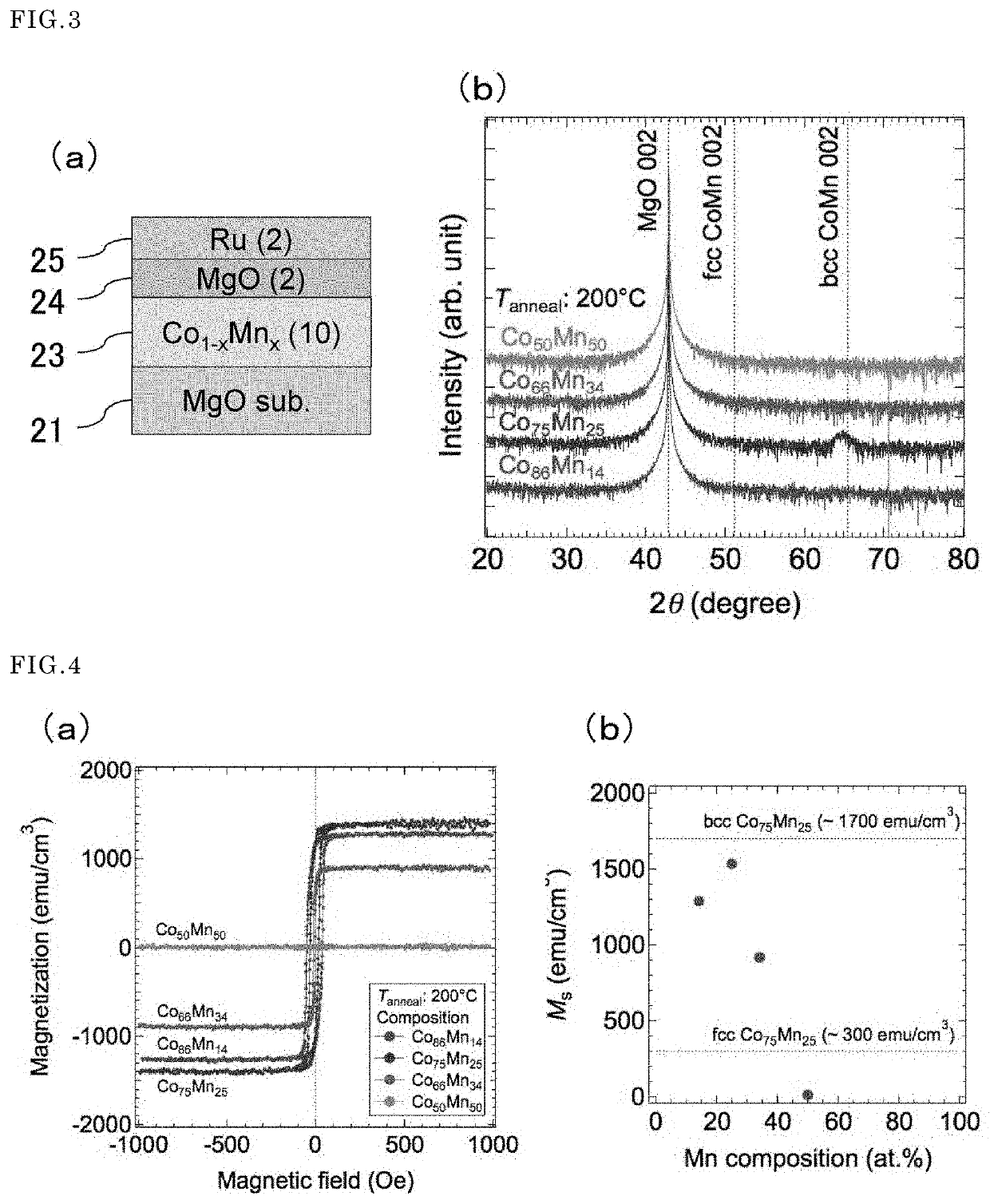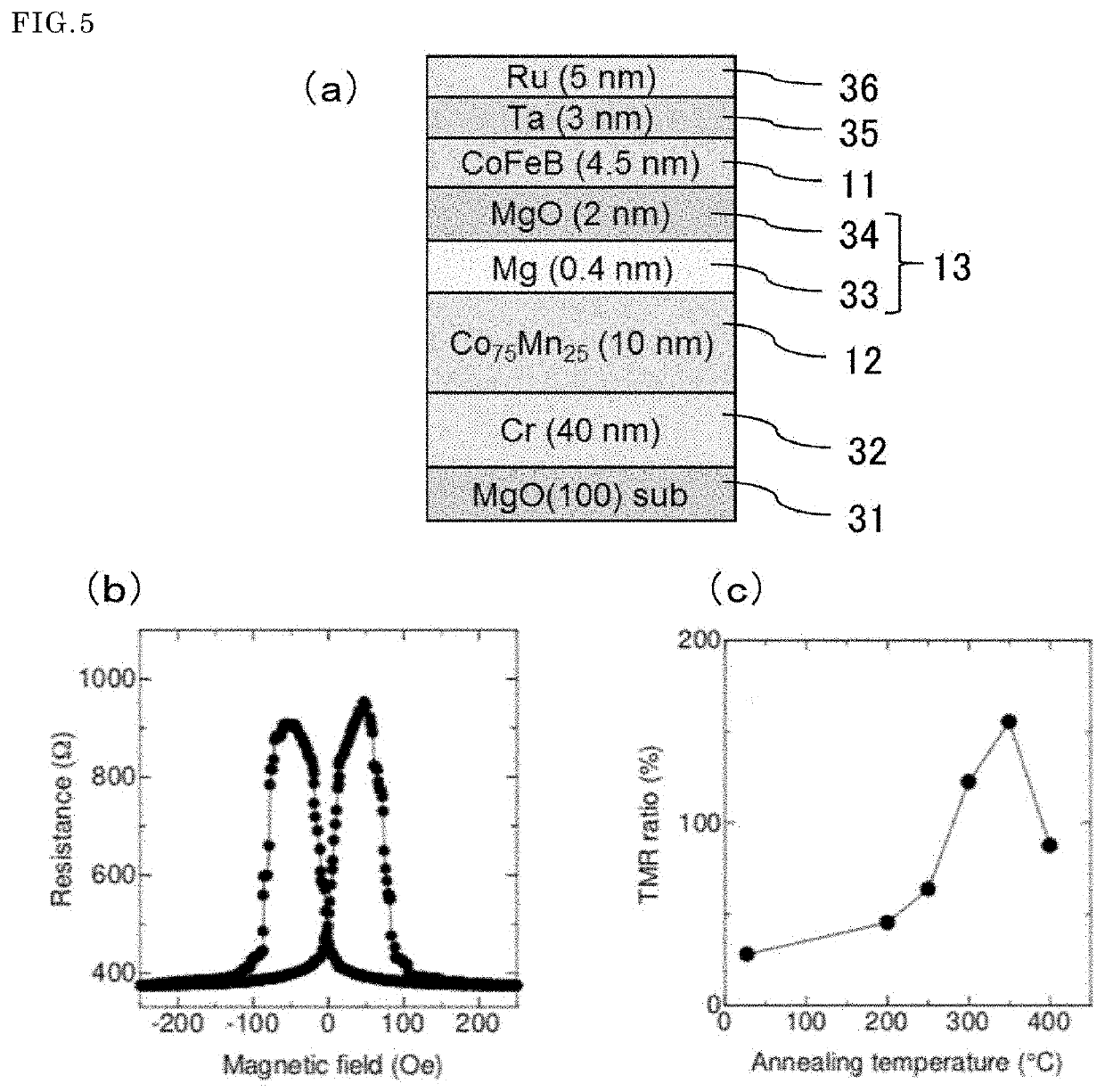Magnetoresistive element and magnetic storage device
a magnetic storage device and magnetoresistive element technology, applied in the direction of electrical apparatus, semiconductor devices, galvano-magnetic material selection, etc., can solve the problems of difficult mass production, difficult to put into practical use, and fixed layer is not thermodynamically stable, etc., to achieve excellent tunnel magnetoresistive ratio, and high speed
- Summary
- Abstract
- Description
- Claims
- Application Information
AI Technical Summary
Benefits of technology
Problems solved by technology
Method used
Image
Examples
example 1
[0048]By sputtering, a magnetic thin film made of an alloy having the bcc structure containing Co as a main component and Co and Mn was manufactured. As illustrated in FIG. 2(a), a Cr layer 22 having a thickness of 40 nm, a CoMn alloy layer 23 made of a Co75Mn25 thin film having a thickness of 10 nm, an MgO layer 24 having a thickness of 2 nm, and an Ru layer 25 having a thickness of 2 nm were sequentially formed on an MgO substrate 21 by sputtering to manufacture a test device. Using the manufactured test device, crystal structure analysis and measurement of magnetization curve (M-H curve) were performed by the X-ray diffraction (XRD) method. The results are illustrated in FIGS. 2(b) and 2(c), respectively.
[0049]As illustrated in FIG. 2(b), in the XRD spectrum, in addition to the peaks corresponding to MgO and Cr, peaks were observed at positions corresponding to CoMn in the bcc structure. In addition, no peak was observed at the position corresponding to the fcc (face-centered cub...
example 2
[0055]By sputtering, a magnetoresistive element 10 in which only the free layer is made of a CoMn alloy having the bcc structure was manufactured. As illustrated in FIG. 5(a), a Cr layer (base layer) 32 having a thickness of 40 nm, a second magnetic layer 12 (free layer) made of a Co75Mn25 thin film having a thickness of 10 nm, a non-magnetic layer 13 made of an Mg film 33 having a thickness of 0.4 nm and an MgO film 34 having a thickness of 2 nm, a first magnetic layer 11 (reference layer) made of a CoFeB thin film having a thickness of 4.5 nm, a Ta layer 35 having a thickness of 3 nm, and a Ru layer 36 having a thickness of 5 nm were sequentially formed on an MgO substrate 31 by sputtering, and then subjected to annealing for 1 hour at a predetermined temperature up to 400° C. to manufacture a test device of the magnetic resistance element 10. The annealing temperature of each test device is 25° C. (without annealing), 200° C., 250° C., 300° C., 350° C., and 400° C.
[0056]The tunne...
example 3
[0058]By sputtering, a magnetoresistive element 10 in which both the free layer and the reference layer were made of a CoMn alloy having the bcc structure was manufactured. As illustrated in FIG. 6A, a Cr layer (base layer) 32 having a thickness of 40 nm, a second magnetic layer 12 (free layer) made of a Co75Mn25 thin film having a thickness of 10 nm, a non-magnetic layer 13 made of an MgO film having a thickness of 2.4 nm, a first magnetic layer 11 (reference layer) made of a Co75Mn25 thin film having a thickness of 4 nm, a CoFe layer 37 having a thickness of 1.5 nm, an IrMn layer 38 having a thickness of 10 nm, and a Ru layer 36 having a thickness of 5 nm were sequentially formed on an MgO substrate 31 by sputtering, and then subjected to annealing for 1 hour at a predetermined temperature up to 375° C. to manufacture a test device of the magnetic resistance element 10. The annealing temperature of each test device is 25° C. (without annealing), 250° C., 300° C., 325° C., 350° C.,...
PUM
 Login to View More
Login to View More Abstract
Description
Claims
Application Information
 Login to View More
Login to View More - R&D Engineer
- R&D Manager
- IP Professional
- Industry Leading Data Capabilities
- Powerful AI technology
- Patent DNA Extraction
Browse by: Latest US Patents, China's latest patents, Technical Efficacy Thesaurus, Application Domain, Technology Topic, Popular Technical Reports.
© 2024 PatSnap. All rights reserved.Legal|Privacy policy|Modern Slavery Act Transparency Statement|Sitemap|About US| Contact US: help@patsnap.com










